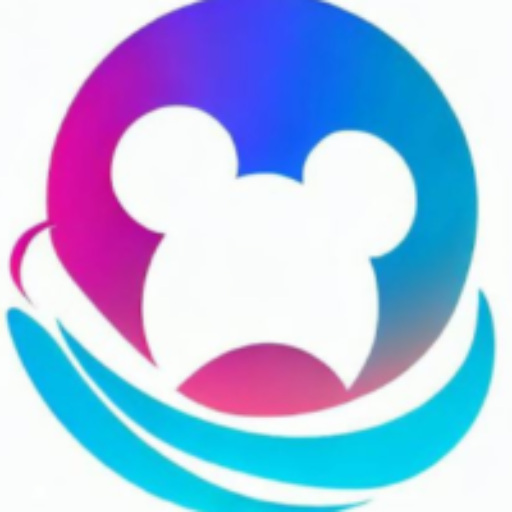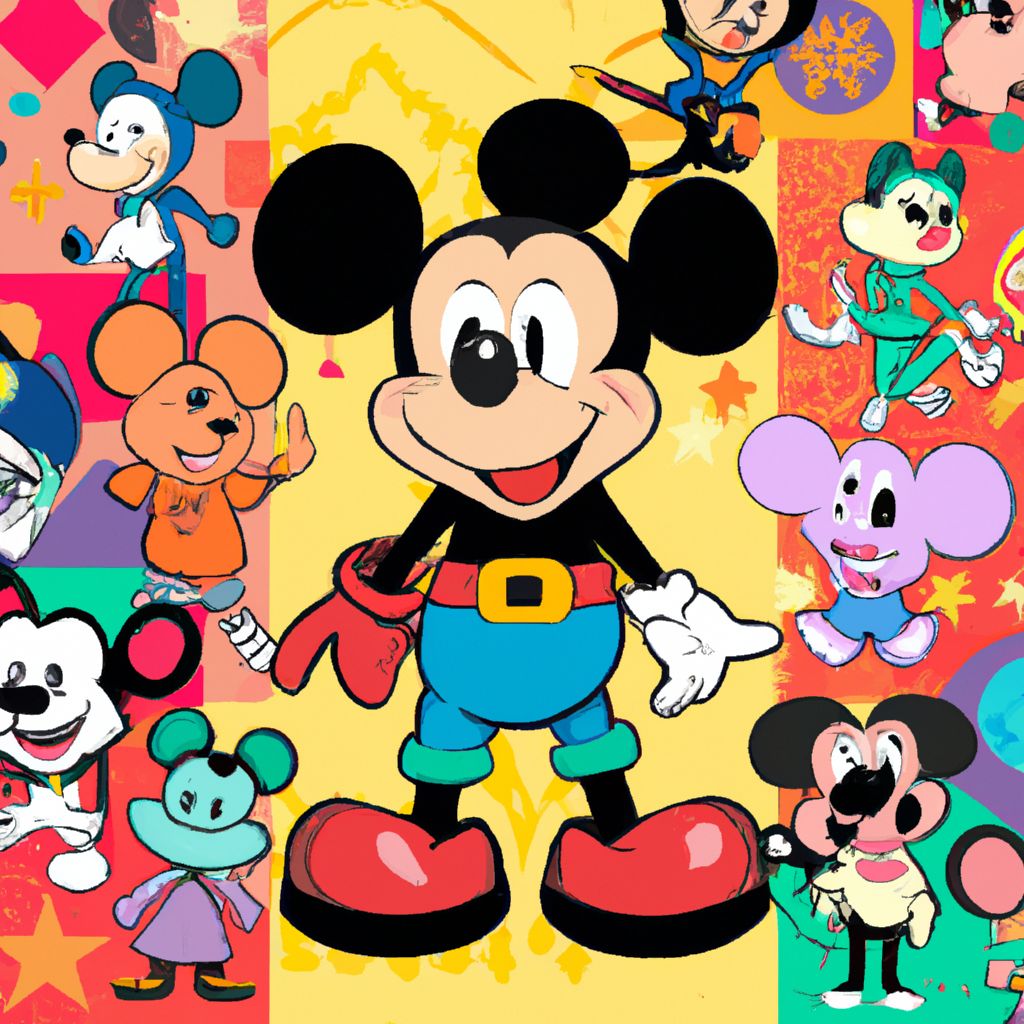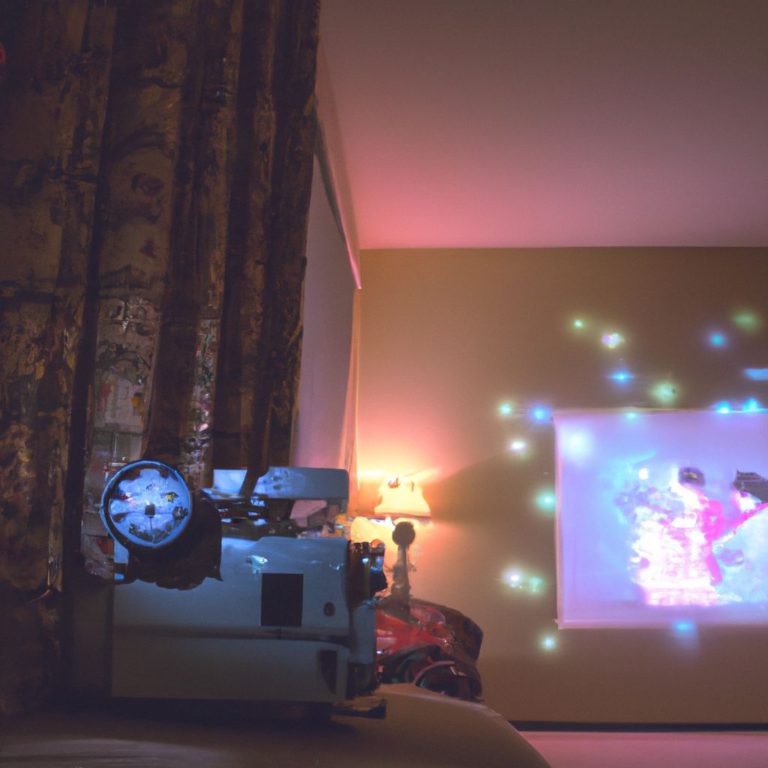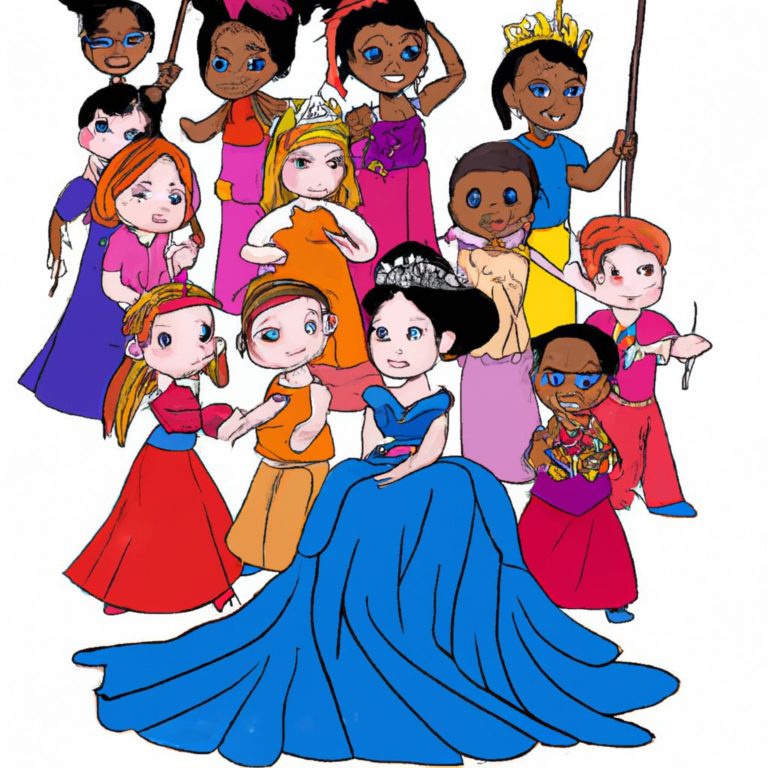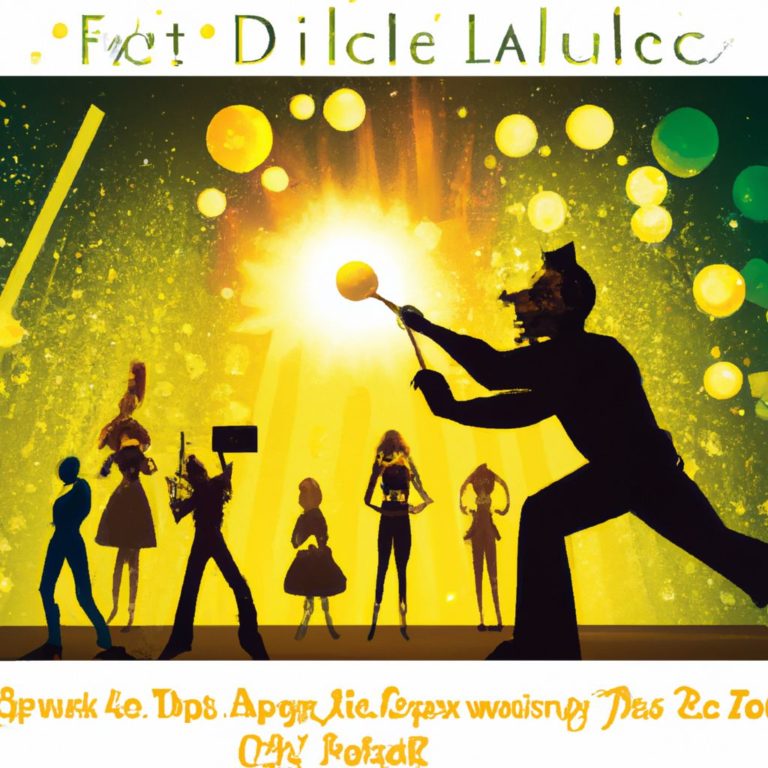Disney’s Influence On Pop Culture
- 100 Disney Facts That Might Surprise You - June 24, 2023
- Secrets Of Disneyland Attractions - June 24, 2023
- Real Life Inspirations Behind Disney Movies - June 24, 2023
The Evolution of Disney: A Journey Through Time
To explore the evolution of Disney and its impact on pop culture, dive into the journey through time. Witness the founding years when Disney began and flourished, experience the golden age with iconic characters and stories, revive the magic with the Disney Renaissance, and witness the modern era as Disney ventures into diverse entertainment mediums.
The Founding Years: How Disney Started and Grew
Disney started small, but grew into a huge entertainment empire. Their creativity was the key to capturing hearts worldwide.
Walt and Roy Disney founded the company in 1923. At first, they made animated shorts. Then Mickey Mouse came in 1928 – this character made the studio soar.
In 1937, Snow White and the Seven Dwarfs was released. It was the first full-length animated film and showed off Disney’s pioneering nature. Other classics followed, like Pinocchio, Fantasia, and Bambi.
Disney didn’t stop there. They started producing television shows like The Mickey Mouse Club and Disneyland. This allowed them to bond with their audience and build a fan base. They also made live-action films, so they could appeal to more viewers.
Pro Tip: Build strong emotional connections with your audience. Understand who you’re targetting and make content that speaks to them personally. From Cinderella’s glass slipper to Sleeping Beauty’s poison apple, Disney taught us that true love is just a curse away.
Disney’s Golden Age: The Birth of Iconic Characters and Stories
Disney’s Golden Age saw the birth of iconic characters and stories. Mickey Mouse, Snow White and Cinderella stole the hearts of audiences everywhere! This era also pushed animation to new heights.
Mickey Mouse was created in 1928, revolutionizing animation. Snow White and the Seven Dwarfs was Disney’s first full-length animated feature in 1937. Cinderella enchanted viewers in 1950, and Fantasia combined classical music with animation. Peter Pan‘s captivating journey to Neverland in 1953 cemented this era’s legacy.
Walt Disney even received an honorary Oscar for Mickey Mouse’s creation! This visionary contribution transformed the entertainment industry forever. The Disney Renaissance followed, bringing us even more gems that everyone could enjoy.
Disney Renaissance: The Revival and Reinvention of Disney Magic
The Disney Renaissance was an amazing leap in the history of Disney. It was a period of rediscovery and reinvention of the company’s beloved magic. During this time, Disney created a series of animated films that enchanted viewers and gave new life to traditional storytelling.
The Disney Renaissance was marked by a return to classic animation techniques, combined with modern storytelling and technology. This mix allowed for greater artistic expression and complexity in the films, which all ages could relate to.
Character development, with strong, relatable characters and emotionally-driven narratives, was key. Films like “The Little Mermaid,” “Beauty and the Beast,” and “The Lion King” featured protagonists with internal struggles and personal growth. These stories were not only entertaining but also taught important life lessons.
The visuals and music of these Disney films were also special. The animators displayed astounding attention to detail. The landscapes were stunningly beautiful, transporting viewers to new worlds. The music, composed by legends such as Alan Menken, added an extra layer of emotionality.
The Disney Renaissance was a box office triumph, showing there was still a strong demand for traditional animated films. People flocked to theaters to experience the magical tales on the big screen, creating anticipation and excitement with each new release. Disney took over the world faster than a kid eating cotton candy at the Magic Kingdom!
Modern Era: Disney’s Expansion into Various Entertainment Mediums
Since 1937, Disney has been making kids believe that talking furniture is normal through their movies. In the modern era, they’ve expanded their reach into various entertainment mediums. This expansion allows them to captivate audiences across different platforms, creating a seamless experience for fans.
Let’s take a closer look at the different mediums through which Disney has made its mark.
Films, such as “Frozen” and “Avengers,” have allowed Disney to dominate the film industry. On television, they have established themselves as a prominent force with animated series and live-action dramas. Disney’s magical world of Disneyland and Disney World allows visitors to step into their favorite stories and characters, creating cherished memories. With an extensive range of merchandise spanning toys, clothing, and collectibles, Disney captivates fans beyond just the screen.
To further enhance their expansion efforts, Disney could consider venturing into new forms of media such as virtual reality or augmented reality experiences. They could also consider collaborations with other popular franchises or brands, offering unique opportunities for cross-promotion and audience expansion.
The Impact of Disney Movies on Society
To understand the impact of Disney movies on society, dive into how Disney films shape childhood, break stereotypes, and inspire imagination. Explore the way Disney movies mold young minds, examine Disney’s efforts to promote diversity and inclusion, and discover how Disney sparks creativity and encourages dreaming big.
Shaping Childhood: How Disney Films Mold Young Minds
Disney movies have a huge influence on society, especially on youngsters. They play a major role in forming their views and opinions. Kids often look up to Disney characters as role models, and are affected by their beliefs, attitudes, and behaviour.
Disney movies are famous for their alluring tales, vibrant animation, and iconic characters. They can transport children to a magical realm where anything is possible. From traditional movies like “Snow White” and “Cinderella” to modern-day hits like “Frozen” and “Moana”, these films enthrall kids worldwide.
A key element of Disney films is their depiction of strong and independent protagonists. Characters like Mulan and Elsa motivate young girls to be courageous, self-confident, and tough in the face of troubles. Likewise, heroes like Simba from “The Lion King” teach boys crucial life lessons about courage, duty, and leadership.
What’s more, Disney movies often communicate strong messages about love, companionship, family values, and the importance of individuality. Films like “Beauty and the Beast” emphasize the importance of looking beyond appearances and embracing one’s true beauty. These themes touch viewers emotionally and can shape their understanding of relationships.
To add to the positive effect of Disney movies on young minds, it is necessary to engage in open conversations with kids about the films they watch. Parents or guardians can stimulate critical thought by asking questions about character motivations or moral issues presented in the movies.
Also, parents can introduce diverse types of media to children to give a comprehensive view on different cultures, experiences, and perspectives. This exposure aids in expanding a child’s worldview beyond what they see just in Disney movies.
By executing these tips in a child’s movie-watching experience, parents can help them sharpen critical thinking skills while having fun with Disney films. Ultimately, taking an active part in guiding children’s interpretation of these movies can make sure that the impact of Disney on young minds remains good and meaningful.
Breaking Stereotypes: Disney’s Efforts to Promote Diversity and Inclusion
Disney has been striving to promote diversity and inclusion in its films, smashing stereotypes while doing so. Here are five points that show Disney’s strategies:
- Embracing Different Cultures: Disney has presented characters from many cultures, giving audiences a light onto diverse customs and practices. This teaches watchers about different cultures and encourages empathy and understanding.
- Breaking Gender Stereotypes: Disney has moved away from traditional gender roles by featuring strong and independent female characters who don’t follow society’s expectations. This communicates a powerful message, inspiring viewers to challenge gender stereotypes in their own lives.
- Representation of People with Disabilities: Disney encourages inclusivity by featuring persons with disabilities, showing they are capable and valuable in society. By normalizing disability representation, Disney demolishes barriers and encourages acceptance.
- LGBTQ+ Representation: Recently, Disney has included LGBTQ+ characters in its movies, such as Officer Specter in “Onward” and LeFou in “Beauty and the Beast”. Through this, Disney is aiming to create a more inclusive world for all viewers.
- Diversity Behind the Scenes: Disney is also working to promote diversity in its creative teams, hiring people from various ethnicities, backgrounds, and perspectives. This allows for genuine storytelling that appeals to diverse audiences.
These efforts are not just for show, but have a real impact on society. By smashing stereotypes in its films, Disney questions social norms and encourages positive change.
To further advance diversity and inclusion in its movies, Disney could consider the following suggestions:
- Intersectional Representation: There has been progress in representing different groups separately, but highlighting intersections of identity can provide a more comprehensive portrayal of diversity.
- Authentic Storytelling: Working with marginalized communities can guarantee their stories are accurately represented on screen while avoiding cultural appropriation or misrepresentation.
- Disability Advocacy: Disney can do more than represent people with disabilities, by actively supporting organizations and initiatives that advocate for their rights and inclusion.
- LGBTQ+ Visibility: Continuous representation of LGBTQ+ characters, plus their accurate and multifaceted storylines, can help increase understanding and acceptance of the community.
- Mentorship Programs: Setting up mentorship programs within Disney can give aspiring filmmakers from underrepresented communities chances to enter the industry and display their unique perspectives.
By applying these ideas, Disney can promote diversity and inclusion in its films, making a lasting effect on society. Through their dedication to breaking stereotypes, Disney keeps forming the entertainment industry as a spark for positive social change.
Inspiring Imagination: How Disney Sparks Creativity and Dreaming Big
Disney movies have an immense effect on society. They reignite imagination and inspire individuals to reach for their dreams. From princesses to talking animals, these films spark creativity in both adults and children.
The enchanting visuals and captivating stories take viewers to a place where anything’s possible. Disney characters serve as motivation for people to pursue their aspirations. Whether it’s a brave young girl or a snowman wanting to experience summer, these stories motivate us.
Plus, Disney films teach us valuable lessons. Characters like Mulan prove that determination conquers any obstacle. Simba from The Lion King reminds us that our future is in our hands. These movies entertain and educate us.
Disney movies also influence society’s norms and values. With diverse characters like Moana and Tiana, Disney promotes acceptance and inclusivity.
Walt Disney was the driving force behind this iconic brand. As a youngster in rural America, he was determined to turn his vision of magical worlds into reality. Despite many challenges, he never gave up on animation.
Disney’s theme parks are like real-life fairy tales. People pay thousands of dollars to wait in long lines and eat overpriced turkey legs. Who needs sanity when you can have Mickey-shaped happiness?
Disney’s Theme Parks: Creating Magical Experiences
To create magical experiences with Disney’s theme parks, delve into the sub-sections: Disneyland, the first park shaping modern entertainment; The Magic Kingdom, revolutionizing the theme park industry; and International Expansion, exploring Disney parks worldwide. Each sub-section highlights a unique aspect of Disney’s influence on pop culture through its enchanting theme parks.
Disneyland: The First Theme Park and Its Influence on Modern Entertainment
Text:
Disneyland is the world’s first theme park and its impact on modern entertainment is undeniable. From its grand opening in 1955, it initiated a trend of amusement parks globally.
Its influence is seen everywhere. Its innovative approach to create immersive and themed environments was revolutionary. Every area within the park is meticulously crafted to transport visitors to a different time or place. This level of craftsmanship continues to inspire designers.
Technology-wise, Disneyland introduced groundbreaking technologies still used today, such as animatronic characters. These figures bring stories to life, captivating audiences.
To build upon its legacy, future theme parks should incorporate new technologies, like virtual reality or augmented reality. Attractions like Star Wars: Galaxy’s Edge at Disneyland, which combine physical sets with interactive elements, are a great example.
Expanding partnerships with other entertainment franchises is another way to further Disneyland’s impact. Collaborations with popular films or TV shows can bring beloved characters and stories to life in the park, attracting a wider audience.
It is clear that Disneyland’s influence on modern entertainment is outstanding. By embracing creativity and innovating, future theme parks can carry on its magical experiences.
The Magic Kingdom: How Disney World Revolutionized the Theme Park Industry
Disney World’s Magic Kingdom changed the theme park industry with its capacity to make magical experiences. Innovative attractions, charming storytelling and excellent customer service set a new standard.
A key factor that makes Magic Kingdom stand out is its commitment to immersing guests in a world of enchantment. From the moment visitors arrive on Main Street U.S.A., they’re in a meticulously designed and crafted environment that captures their imagination. Every building, sign – even the trash cans – are perfectly themed.
Plus, Disney World introduced amazing technologies and attractions. Iconic animatronic characters brought stories to life. From Pirates of the Caribbean to It’s a Small World, these attractions showed Disney’s commitment to creating an immersive experience.
To improve the guest experience, Disney World’s Magic Kingdom could explore incorporating interactive elements into its attractions. This could involve virtual reality tech or interactive components where guests can take part in the storytelling.
To take it further, behind-the-scenes tours or special access events could be another way to raise the park’s status. Providing guests with exclusive chances to learn about how Disney’s beloved attractions are made would teach and add value.
Disney World’s Magic Kingdom revolutionized the theme park industry with its storytelling techniques, technological advancements, and exceptional customer service. It sets an example for other parks to follow. No wonder it is a top choice for families and individuals seeking adventures in entertainment.
International Expansion: Disney Parks Around the World
Disney has brought its extraordinary magic to various places around the world. Let’s take a look at some of its incredible Disney parks:
| Park Name | Location | Year Opened |
|---|---|---|
| Disneyland | Anaheim, California | 1955 |
| Walt Disney World | Orlando, Florida | 1971 |
| Tokyo Disneyland | Urayasu, Japan | 1983 |
| Disneyland Paris | Marne-la-Vallee, France | 1992 |
| Hong Kong Disneyland | Lantau Island, Hong Kong | 2005 |
| Shanghai Disney Resort | Pudong, Shanghai, China | 2016 |
Tokyo Disneyland is known for its detail and customer service. Disneyland Paris adds a touch of European charm. Hong Kong Disneyland blends Chinese culture with Disney enchantment. And, Shanghai Disney Resort celebrates China’s love for all things Disney.
But, before international expansion, two beloved Disney parks were in the US. In 1955, Disneyland opened in Anaheim, California. Then, in 1971, Walt Disney World opened in Orlando, Florida.
Disney’s vision of creating unforgettable experiences has now spread to people worldwide. From the nostalgia of classics like Disneyland to the modern marvels of Shanghai Disney Resort – each park offers an opportunity to escape and immerse yourself in a magical world.
Disney’s Multimedia Empire: Reaching beyond the Big Screen
To better understand how Disney has shaped pop culture, let’s explore the multimedia empire they’ve built. Discover how Disney’s influence extends beyond the big screen by delving into their impact on television with shows like The Mickey Mouse Clubhouse and their dominance in merchandise and brand cultural presence. Additionally, we’ll examine the streaming success of Disney+ and its implications for the future of entertainment.
Television Dominance: Disney’s Influence on the Small Screen
Disney is a multimedia giant, with a dominant influence on the small screen. They’ve made their mark in movies and TV shows, captivating audiences of all ages. From “The Mickey Mouse Club” to “Hannah Montana,” they’ve created classics. Popular shows like “The Suite Life of Zack & Cody” and “Kim Possible” are cultural phenomena.
Disney also ventures into more mature content, with shows like “Grey’s Anatomy” and “Scandal.” By partnering with renowned creators and studios, they’ve expanded their reach even further. They’ve successfully integrated their existing franchises into shows, from “Raven’s Home“ to crossover events.
Disney-owned channels such as ABC, ESPN and Freeform have added to their success. Diversifying their portfolio, they cater to a wide range of interests. Through their acquisition of 21st Century Fox, they now own one-third of Hulu. This strategic move solidifies their position as a multimedia empire. Disney’s merchandising game is so strong, they can practically sell you your own childhood memories.
Merchandising Powerhouse: Disney’s Cultural Presence in Products and Brands
Disney has become a big player in the merchandising world. Let’s have a look at how.
Their products include:
- Apparel
- Home Decor
- Accessories
- Beauty and Cosmetics
- Toys and Games
- Collectibles
- Books and Comics
- Stationery and Office Supplies
Their iconic characters and stories have made Disney a powerhouse in many markets. Disney even ventured into beauty and cosmetics – offering fans a fun way to add a little Disney to their daily lives.
This all began in 1929 when they released Mickey Mouse dolls. Disney has leveraged its cultural presence to become an empire with a range of products. From apparel to home decor, to beauty products, they have won hearts all over the world.
Disney+ is like a genie that grants all your entertainment wishes, without trying to marry your teenage daughter.
Streaming Success: Disney+ and the Future of Entertainment
Disney+ has changed the entertainment industry with its streaming platform that goes beyond the big screen. With its vast collection of movies, TV shows, and original content, millions of people around the world have become subscribers. Streaming services like Disney+ are now part of our lives.
Disney+ has adapted to the changing needs and preferences of users. It has a user-friendly interface and many content choices. From classic animated films to the newest Marvel movies, everyone can find something they like.
Disney+ stands out for its focus on original content. For example, it produced the series “The Mandalorian” and “WandaVision”. These productions have been praised and have their own fan base. By investing in quality storytelling and production, Disney+ has created its own space.
Being part of the Disney+ community means staying up to date. Fans can share their theories and discuss character development. Joining this vibrant community adds to the viewing experience. Don’t miss out on all the fun!
